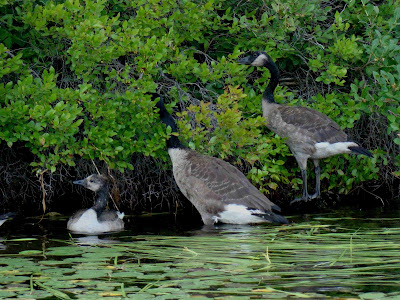 |
| One day-old loon chick riding on its parents' back |
Chick and parent were staying near the island and communicating with its mate who was still on the nest, but there's no indication that a second egg hatched, or will hatch. The next week is the most critical for Lake Wicwas's newest inhabitant, and a lot of good fortune will have come together for it to survive. Time will tell....
This week seemed to have an avian theme. On one trip on the lake, we counted at least 35 Canada Geese swimming together in a giant flotilla. And later, along the shore of the lake, they were feasting on huckleberries which are ripe and quite abundant this year.
 |
| Canada Geese Feasting on Huckleberries |
Back closer to home, we didn't have to search out a Great Blue Heron - one came to visit us right on our dock!
 |
| Great Blue Heron |
OK, so this isn't too exciting, but it's still a pretty bird with a pretty song:
 |
| American Robin |
But right next to it are a dozen tiny seedlings that it had spawned from its pine cones, so in a hundred years, it will have resurrected itself.
While I was studying this tree, I also observed an oak leaf that had been almost totally consumed by caterpillars.
If you were on the lake this weekend, you undoubtedly noticed a lot of boat traffic, including a pretty Hobie Cat cheating the wind.
In fact, on Saturday there were over 60 boats inspected as they came in or out at the boat landing - a record as far as our Lake Host coordinator knows. That's an awful lot of opportunity for invasive species like Milfoil to enter our lake, so please thank our volunteers for being lake hosts. And we always need more, as there are many hours the ramp goes unstaffed, so please volunteer to be Lake Host and help keep Lake Wicwas pristine. (Send me an email, or leave a comment if you need to know who to contact to volunteer.)
As one last salute to birds this week, this interesting creature buzzed over the lake on one of those fabulous summer afternoons.
















































